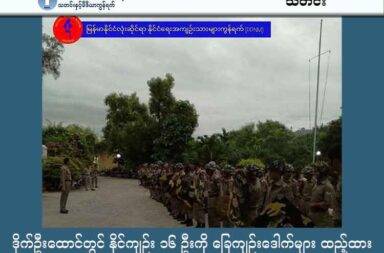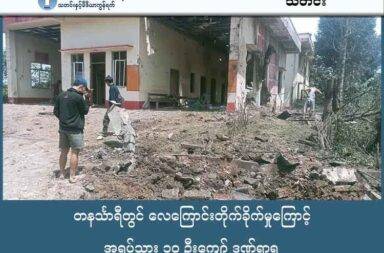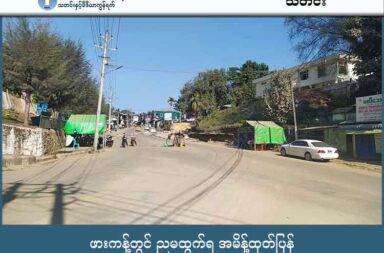Nearly 2,000 Kutkai IDPs in Need of Food Aid
By NETWORK MEDIA GROUP (NMG)
Tuesday, August 26, 2019
Some 2,000 internally displaced people (IDPs) in Kutkai, northern Shan State are in need of food after being displaced from their homes by fighting between the Burma Army and the Northern Alliance of ethnic armed groups.
Hawng Dau, spokesperson for the Humanitarian Strategic Team-Northern Shan State (HST-NSS), said that even though volunteer groups, local civil society organizations (CSOs), and religious groups have provided shelter and food assistance to IDPs, the number of displaced people continues to grow.
“There are over 1,800 IDPs in Kutkai…nearly 400 IDPs arrived in Kutkai today,” Hawng Dau told NMG on Monday. “Currently, they need basic food products. Even though local CSOs provide food to them, it’s not enough. We provide rice, cooking oil, salt and beans. They mainly need basic food products.”
According to local CSOs, over 200 IDPs have sought refuge in Maharsi Tharthana Yeiktha monastery in Kutkai. Nearly 230 are staying in Karlai Kachin church, more than 200 IDPs are in Mang Pyein monastery. Some 300 people are staying in office of the Ta’ang Literature and Culture Association. Nearly 550 IDPs are in Kho Long monastery, and nearly 500 IDPs are staying in Tawng Tan monastery. Some 50 IDPs are in the Hkanan church, 80 are in the Aik Moong Ta’ang boarding school, and nearly 100 IDPs are seeking refuge in their relatives’ homes in Kutkai.
According to local CSOs, the most recent arrivals include 350 villagers from Loi Pel, who arrived at various Kutkai monasteries early this week
“Loi Pel villagers called us to pick up them in their village today. So local CSOs brought them to downtown Kutkai this morning,” Ko Myo, who works for the Hsipaw-based Volunteers Without Borders, said on Monday. “A shell landed in Loi Pel village yesterday. A family got injuries. We place them in the Taung Tan monastery in this morning.”
Villagers also from Kon Hser, Nam Hudae, Nam Kut, Ho Nawng, Shu Khin Tha, Nawng Swe, Nam Perchi, Per Kyu and Hpoung Hseng—as well as 200 construction workers—have sought refuge in Kutkai.
According to reports from the HST-NSS, there are currently more than 5,500 IDP in northern Shan State displaced since August 15. In total, people from 46 villages in four townships in have sought refuge in 22 temporary IDP camps and relatives’ homes in the region.
HST-NSS also has said that casualties have increased, as well as people being forced to flee in Lashio, Hsenwi, Kutkai, Namphetka and Namkham townships.
“Some travelers are still trapped on the national highway. We haven’t been able to communicate with them. Some vehicles are trapped between Kutkai and Namphetka. Some people can not leave their villages because clashes are occurring near their village,” Hawng Dau said.
Authorities have closed schools in conflict-affected townships. Some roads are blocked and locals have been unable to tend to their farmland. CSOs say they are in need of food and basic health support.
“We want to demand that both forces stop the war,” Hawng Dau said of the Burma Army and ethnic armed forces. “Both forces need to avoid clashes near villages and towns… both forces need to avoid civilian casualties.”
Maj Mai Aik Kyaw, spokesperson for the Ta’ang National Liberation Army (TNLA)—one of three groups involved in the clashes with the Burma Army, in addition to the Myanmar National Democratic Alliance Army (MNDAA) and the Arakan Army (AA)—told NMG that the government forces are exacerbating the conflict.
“The clashes depend on their offensives. If there are no offensives, there will be no clashes. To stop the war, both sides need to meet for negotiation,” Maj Mai Aik Kyaw said. “We need effective and workable negotiations between the two parties. Negotiations must be accepted by both sides. If negotiations go well, I think the number of clash will be reduced.”
Clashes have been ongoing for more than 10 days. On August 15, the TNLA, MNDAA and AA launched coordinated attacks on military and police targets in Pyin Oo Lwin and northern Shan State. Fighting against the groups in northern Shan State has intensified since then.


